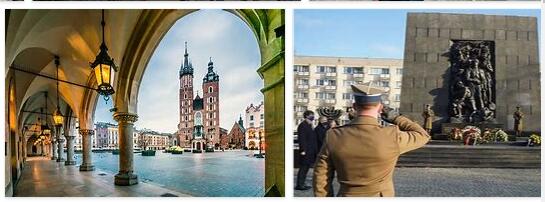The importance of this union, which subtracted a part of the Polish-Lithuanian subjects from the interference of the Moscow patriarchate, was all the greater, since with the extinction of the Rjurik dynasty the opportune moment for a decisive affirmation of Polish supremacy in Eastern Europe. In fact, the help of some Polish magnates granted to the usurper Demetrius and the subsequent official intervention of Poland against Tsar Vasilij Shuiskij, allied with Charles IX of Sweden, induced the Muscovites, thanks to the victory of Żółkiewski at Klušin (1610), to offer the Russian throne to Prince Vladislaus, son of Sigismund. But the success was ephemeral despite the revival of Smolensk (1611) and the triumph of Zólkiewski who led Shujskij himself to Warsaw as a Polish prisoner: the king desired for himself what some Russians were willing to offer to his son, and a few thousand Poles remaining in the Kremlin had to capitulate (1612) in the face of the vigorous Russian reaction that installed Michael Romanov on the throne of Moscow. But the resumption of the campaign against the Russians led to military successes which allowed Poland (Deulino’s armistice, 1619) to enlarge its territory to the east, but the possibility of a Polish-Russian union had definitively vanished. as a Polish prisoner, Shuysky himself: the king coveted for himself what some Russians were willing to offer to his son, and the few thousand Poles left in the Kremlin had to capitulate (1612) before the vigorous Russian reaction that installed Michael on the throne of Moscow Romanov. But the resumption of the campaign against the Russians led to military successes which allowed Poland (Deulino’s armistice, 1619) to enlarge its territory to the east, but the possibility of a Polish-Russian union had definitively vanished.
Even in the face of the increasingly complex political conditions of the states bordering Poland to the south, the king, rather than protecting Polish interests, stood as champion of Catholicism. Fatal was above all the aid granted to the emperor, threatened at the very gates of Vienna by the Transylvanian prince Gabriele Bethlen. The war with Turkey followed (defeat at Cecora in 1620, victory at Chocim in 1621), which Gustavo Adolfo took advantage of to occupy Riga (1621) and a large part of eastern and Polish Prussia (1626). Nor did the subsequent Polish victories by land and sea bring it out of the conquered territories. But it was still a temporary danger; the most lasting and most serious danger for Poland had already occurred in 1618: in that year East Prussia had united.
According to picktrue.com, Superior in every respect to his father was his son and successor Vladislao IV (1632-1648), who distinguished himself above all as a good warrior and reorganizer – but still on the main basis of mercenary troops – of the Polish army.
He was responsible for the successes of the Poles against the Russians (peace of Polanów of 1634) and against the Swedes (armistice of Sturmdorf of 1635). On the other hand, due to the opposition of the nobility, he was not allowed to carry out his great project, conceived in agreement with Pope Innocent X and with Venice, of a new crusade against the Ottomans.
Cossacks should have participated in this enterprise – a population of mixed origin, which arose on the borders of Poland; warriors and marauders dangerous to enemies for their skill, to friends for their indiscipline – who had already rendered useful services to the republic before. But their organization was opposed by the Ukrainian magnates, owners of immense territories, who, supported by diets, wanted to reduce them to simple peasants, devoid of any rights. The Cossacks reacted with the revolt which, led by Bohdan Chmielnicki, broke out on the eve of Vladislaus’ death and which at the beginning of the reign of his brother Casimir (1648-1668) threatened to overwhelm all of Poland, raising the plebs of the Ruthenian lands against the nobles, the clergy and the Jews, stirring up the problem of complete independence of these regions from the Polish sovereignty and dragging enormous masses of Tatars with them. Victorious at first, but defeated in 1651 at Beresteczko, Chmielnicki, careless of the agreements concluded with Poland, first tried to ally himself with the Turks and then with the Russians, who immediately promised the Cossacks ample autonomy, attacked Poland and occupied it. to the east vast territories with Polock, Smolensk and finally (1655) also Vilna. Exhausted and bled, Poland seemed to be at the mercy of the invaders. This state of affairs was promptly exploited by the Swedish king Carl Gustav who in a few months, aided by Polish traitors who submitted Great Poland to his protection and united Lithuania to Sweden, traveled with his soldiers almost all of Poland, of which only a few flaps (between other the city of Lviv) managed to preserve their independence. The king himself fled to Silesia, while all the Polish provinces paid homage to the victor.
But then gradually Poland recovered; small units of troops, among which there was no shortage of bourgeois and peasants, began to harass the Swedes; the heroic defense of the Częstochowa monastery was considered miraculous and contributed greatly to arousing spirits; much of the territory was liberated by the invaders, and a provisional armistice was concluded with Russia. Unable to tame it alone, Carl Gustavo conceived the first concrete project of a partition of Poland. But the Transylvanian prince Rákoczy, on whose intervention he counted a lot, was immediately defeated, and he himself had to defend himself from the Danes, aided by the Poles under the leadership of Stefano Czarniecki, who in the most difficult moments of the previous years had been the most valid defender of the Poland.
